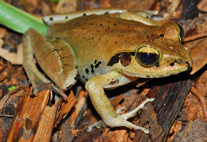Abstract
Molecular genetic studies have in recent years revealed the presence of hidden species diversity in Madagascar's amphibians, and numerous genera contain candidate species awaiting description. We here revise the taxonomy of one such genus within the endemic Malagasy-Comorian family Mantellidae. The target taxon, Aglyptodactylus, is classified in the subfamily Laliostominae and to date contained three recognized nominal species. We focus in particular on clarifying the status of three candidate species proposed for the genus, and for this purpose integrate evidence from molecular genetics, bioacoustics and morphology. We furthermore summarize the information available for all species in the genus concerning their taxonomic identities, distributions and advertisement calls. Our analyses of advertisement calls revealed significant differences coinciding with major clades revealed by phylogenetic analysis of the mitochondrial 16S rRNA gene. Together with the new molecular dataset this provides clear evidence for evolutionary lineage divergence and supports the three candidate species previously characterized by mtDNA divergence of single specimens only. We also observed morphological differences among some of the lineages but these were in most cases not unambiguously diagnostic. As a taxonomic consequence we describe two new species: Aglyptodactylus australis sp. nov. from Andohahela rainforest in southeastern Madagascar, which so far is the largest species known in the genus with females reaching 82.5 mm snout-vent length; and Aglyptodactylus chorus sp. nov. from northeastern lowland rainforests in the Maroantsetra region. For the third proposed and confirmed candidate species we resurrect the name Rana inguinalis Günther, 1877 as Aglyptodactylus inguinalis (Günther, 1877) from the synonymy of A. madagascariensis. This name is applied to populations distributed in lowlands along most of the east coast of Madagascar, from Marojejy in the north southward to Tolagnaro. Genetic data indicate strong differentiation of A. inguinalis with three sub-lineages receiving support, and we cannot exclude that A. inguinalis as defined herein is a complex of species warranting further partition in the future. As a result of the revised taxonomy, A. madagascariensis remains restricted to rainforests at higher elevations (650‒1500 m a.s.l.) ranging from northern to south-central Madagascar, and showing some further differentiation with respect to a northern and a southern sub-lineage. Difficulties in the assignment of historical type specimens are discussed, as well as the biogeography and conservation status of the recognized species.

